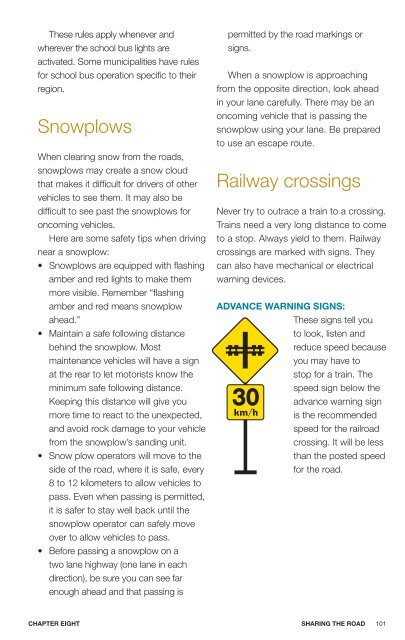DRIVER’S GUIDE
1POl7Ob
1POl7Ob
You also want an ePaper? Increase the reach of your titles
YUMPU automatically turns print PDFs into web optimized ePapers that Google loves.
These rules apply whenever and<br />
wherever the school bus lights are<br />
activated. Some municipalities have rules<br />
for school bus operation specific to their<br />
region.<br />
Snowplows<br />
When clearing snow from the roads,<br />
snowplows may create a snow cloud<br />
that makes it difficult for drivers of other<br />
vehicles to see them. It may also be<br />
difficult to see past the snowplows for<br />
oncoming vehicles.<br />
Here are some safety tips when driving<br />
near a snowplow:<br />
• Snowplows are equipped with flashing<br />
amber and red lights to make them<br />
more visible. Remember “flashing<br />
amber and red means snowplow<br />
ahead.”<br />
• Maintain a safe following distance<br />
behind the snowplow. Most<br />
maintenance vehicles will have a sign<br />
at the rear to let motorists know the<br />
minimum safe following distance.<br />
Keeping this distance will give you<br />
more time to react to the unexpected,<br />
and avoid rock damage to your vehicle<br />
from the snowplow’s sanding unit.<br />
• Snow plow operators will move to the<br />
side of the road, where it is safe, every<br />
8 to 12 kilometers to allow vehicles to<br />
pass. Even when passing is permitted,<br />
it is safer to stay well back until the<br />
snowplow operator can safely move<br />
over to allow vehicles to pass.<br />
• Before passing a snowplow on a<br />
two lane highway (one lane in each<br />
direction), be sure you can see far<br />
enough ahead and that passing is<br />
permitted by the road markings or<br />
signs.<br />
When a snowplow is approaching<br />
from the opposite direction, look ahead<br />
in your lane carefully. There may be an<br />
oncoming vehicle that is passing the<br />
snowplow using your lane. Be prepared<br />
to use an escape route.<br />
Railway crossings<br />
Never try to outrace a train to a crossing.<br />
Trains need a very long distance to come<br />
to a stop. Always yield to them. Railway<br />
crossings are marked with signs. They<br />
can also have mechanical or electrical<br />
warning devices.<br />
ADVANCE WARNING SIGNS:<br />
These signs tell you<br />
to look, listen and<br />
reduce speed because<br />
you may have to<br />
stop for a train. The<br />
speed sign below the<br />
advance warning sign<br />
is the recommended<br />
speed for the railroad<br />
crossing. It will be less<br />
than the posted speed<br />
for the road.<br />
CHAPTER EIGHT<br />
SHARING THE ROAD 101


